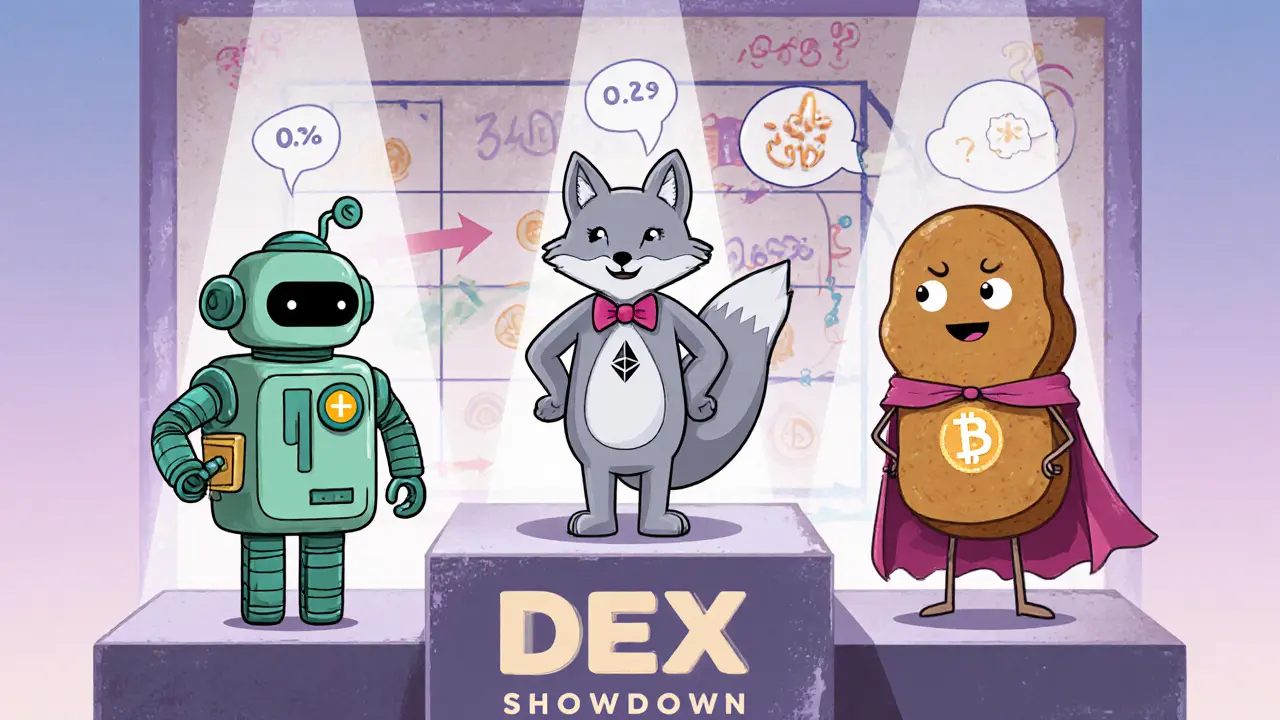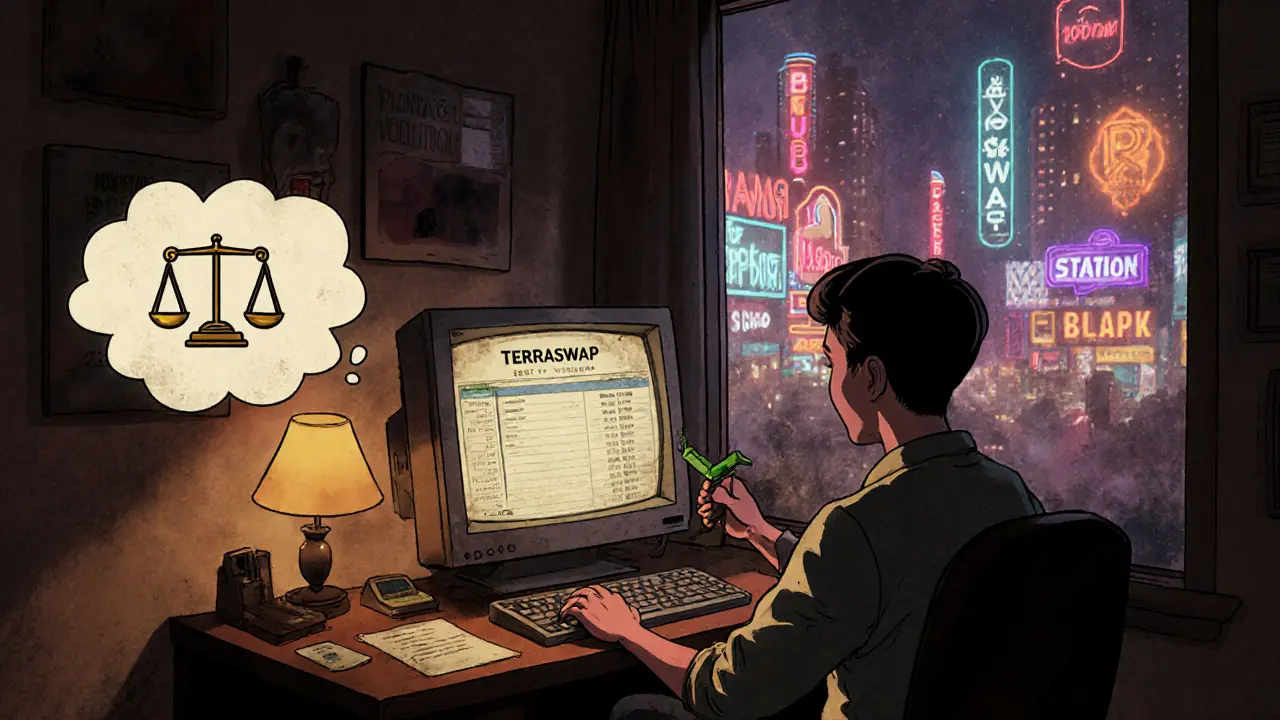Terraswap vs. Other DEXs Comparison Tool
Compare DEX Features
Select two DEXs to compare their key features side-by-side.
Comparison Results
Key Takeaways
- Terraswap is the pioneer AMM DEX on the Terra ecosystem, launched in 2020 by DELIGHT LABS.
- Since the Terra collapse in 2022, daily volume has fallen to near‑zero, making it a niche platform today.
- The protocol charges a flat 0.3% fee that goes directly to liquidity providers; there is no native governance token.
- Access requires the Terra Station Extension (Chrome only), which adds a usability hurdle for newcomers.
- Security audits are unclear - the team claims audits but external sources list none, so caution is advised.
Anyone searching for a Terraswap review wants to know whether the exchange still offers real value, how it works under the hood, and if the risks are worth taking. Below we break down the protocol’s history, technical design, current market data, user experience, and future outlook so you can decide if you should keep an eye on Terraswap or look elsewhere.
What Is Terraswap?
Terraswap is a decentralized exchange (DEX) built on the Terra blockchain that uses an automated market‑maker (AMM) model to swap Terra‑native assets and custom CW20 tokens. Launched on November 13, 2020 by DELIGHT LABS - a team that also runs validator nodes for multiple networks - Terraswap was the first AMM DEX in the Terra ecosystem.
The platform’s core promise is “no custody, no middle‑man”: users keep control of their private keys, and every trade settles on‑chain through smart contracts.
How Terraswap Works
The engine behind Terraswap is an Automated Market Maker (AMM) protocol that creates liquidity pools for any two supported tokens. Liquidity providers (LPs) deposit equal‑value amounts of each token into a pool and receive LP tokens that represent their share.
Key technical pieces:
- All swaps follow the constant‑product formula (x*y=k), ensuring price slippage grows with trade size.
- Every trade incurs a flat 0.3% fee, which is automatically added back to the pool - effectively rewarding LPs.
- The protocol supports native Terra coins like Luna and the algorithmic stablecoin UST, as well as any CW20 token Terra’s equivalent of ERC‑20.
- New token pairs can be created by anyone; the contract auto‑listings mean there’s no manual vetting process.
Because the liquidity is supplied by the community, Terraswap does not issue a native governance token - the protocol’s utility is limited to swapping and earning pool fees.
Security, Audits, and Trust
Security is a major concern for any DEX. DELIGHT LABS claims that Terraswap’s smart contracts “were audited to eliminate vulnerabilities,” but independent sources such as DeFiTeller list **no published audit reports**. The lack of a publicly available audit creates uncertainty, especially given the Terra ecosystem’s turbulent history.
In practice, the protocol’s simplicity (a handful of immutable contracts) reduces the attack surface, but users should still:
- Verify contract addresses directly from the official Terraswap site.
- Avoid large, single‑transaction swaps that could expose price‑impact bugs.
- Consider only swapping tokens with known, audited codebases (e.g., Luna, UST, Mirror assets).

Current Activity and Market Data (Oct2025)
Terraswap’s activity has collapsed alongside the Terra ecosystem. As of October2025:
- Both the standard Terraswap and TerraswapClassic versions report **zero daily trading volume**.
- CoinGecko and CoinMarketCap label the exchange’s volume as “untracked,” indicating negligible activity.
- The platform lists 0 active trading pairs, essentially rendering it a dormant protocol.
These figures put Terraswap in the 4th percentile of DEX volume worldwide - far behind even niche platforms on thriving ecosystems.
User Experience and Accessibility
To interact with Terraswap you must use the Terra Station Extension a Chrome‑only wallet that connects your Terra address to the DEX. The extension adds several friction points:
- Browser lock‑in: only Google Chrome is supported, excluding Safari, Firefox, and mobile browsers.
- Learning curve: new users must install the extension, create a Terra address, and fund it with LUNA or UST before any swap.
- Network fees: each transaction pays the underlying Terra gas fee, which can spike during network congestion.
Because the platform lacks a web‑only “connect wallet” option, many modern DeFi users simply skip Terraswap in favor of DEXs that support MetaMask, WalletConnect, or other mainstream wallets.
How Terraswap Stacks Up Against Other DEXs
| Feature | Terraswap | Uniswap | PancakeSwap |
|---|---|---|---|
| Underlying Chain | Terra (Classic) | Ethereum | Binance Smart Chain |
| Launch Year | 2020 | 2018 | 2020 |
| Swap Fee | 0.3% | 0.3% | 0.25% |
| Native Governance Token | None | UNI | CAKE |
| Daily Volume (Oct2025) | $0 (untracked) | $2.1B | $1.3B |
| Wallet Compatibility | Terra Station (Chrome) | MetaMask, WalletConnect, etc. | MetaMask, Trust Wallet, etc. |
From the table it’s clear that Terraswap lags dramatically in liquidity, user base, and ecosystem support. The lack of a governance token also means no incentive for community‑driven upgrades, unlike Uniswap’s UNI or PancakeSwap’s CAKE.
Pros and Cons
- Pros
- First‑mover AMM on Terra - historically a hub for stablecoins and synthetic assets.
- Flat 0.3% fee that goes entirely to LPs, no hidden costs.
- No native token to dilute value; pure utility focus.
- Cons
- Near‑zero trading volume makes slippage huge for any sizable trade.
- Only Chrome‑based Terra Station Extension is supported - a steep barrier for newcomers.
- Unclear audit status leaves security questions unanswered.
- Dependent on a struggling Terra ecosystem; recovery prospects are uncertain.
Future Outlook
Terraswap’s fate is tightly coupled with the Terra Classic network. If the community manages to revive Terra’s DeFi projects or migrates promising assets to a new chain, Terraswap could see a modest resurgence. However, the current ecosystem signals are bleak:
- Most Terra‑based projects have either shut down or migrated to other blockchains.
- DELIGHT LABS continues to run validators on unrelated networks, indicating they have shifted focus away from Terraswap’s growth.
- Without a governance token or clear upgrade roadmap, attracting new liquidity providers will be an uphill battle.
For users who already hold Terra‑native tokens and want to experiment with AMM mechanics, Terraswap remains a low‑cost sandbox. For anyone seeking active liquidity, competitive fees, and a vibrant community, platforms on Ethereum, BSC, or Polygon are safer bets.

Frequently Asked Questions
Is Terraswap still usable in 2025?
Yes, the smart contracts are still deployed and can be accessed via the Terra Station Extension, but trading volume is virtually nil, so expect high slippage and limited token pairs.
Do I need a native Terra token (LUNA) to use Terraswap?
You need some Terra‑compatible asset (LUNA, UST, or any CW20 token) to pay transaction fees and to provide liquidity. Without funds on Terra, the DEX cannot be used.
Has Terraswap been audited?
The team claims an audit took place, but reputable third‑party sources have not published any audit reports, so the claim remains unverified.
Can I earn rewards by providing liquidity?
Yes. Liquidity providers receive LP tokens that accrue a share of the 0.3% swap fee from that pool. There is no extra token incentive, only fee share.
How does Terraswap compare to Uniswap?
Uniswap operates on Ethereum with billions of dollars in daily volume, supports dozens of wallets, and has a governance token (UNI). Terraswap runs on Terra Classic, has near‑zero volume, supports only the Chrome‑based Terra Station, and has no governance token. Uniswap is vastly more liquid and user‑friendly.


Christina Norberto
March 26, 2025 AT 18:30In the labyrinthine corridors of modern decentralized finance, one must first acknowledge the insidious architecture that underlies platforms such as Terraswap, a construct whose very existence appears to be a conduit for the clandestine orchestration of market manipulation by unseen cabals; the absence of a governance token is not a virtue but a veil, a deliberate attempt to conceal the true hierarchies of power that operate beyond the public ledger; the claim of audit compliance, when juxtaposed against the stark reality of missing third‑party verification, suggests an elaborate smokescreen designed to lull the complacent investor into a false sense of security; the reliance on a singular Chrome‑only wallet extension further reinforces the narrative of technological gatekeeping, restricting access to a narrow demographic while marginalizing the broader user base; the historic collapse of the Terra ecosystem in 2022 serves as a watershed moment, exposing the fragility of ecosystems built upon algorithmic stablecoins and highlighting the pernicious ripple effects on ancillary protocols such as Terraswap; the current near‑zero volume is not merely a symptom of market apathy but a quantifiable indicator of systemic decay, wherein liquidity providers are disincentivized by the prospect of negligible returns; the flat 0.3% fee, while ostensibly equitable, becomes a punitive levy when slippage escalates due to insufficient depth, effectively eroding any marginal gains; the absence of a native token eliminates any possibility for community‑driven evolution, locking the protocol in a static state vulnerable to obsolescence; the purported “first‑mover advantage” is illusory, as history demonstrates that early entrants without robust governance frameworks are swiftly eclipsed by more adaptable competitors; the structural design, rooted in the constant‑product formula, while mathematically elegant, does not compensate for the lack of external incentives that drive sustained liquidity; the reliance on Terra Station as the sole gateway introduces a single point of failure, susceptible to browser exploits and user error; the broader narrative of DeFi democratization is thus contradicted by the very mechanics of Terraswap, which perpetuate exclusivity under the guise of decentralization; the speculation that Terraswap might experience a renaissance is contingent upon the revival of the Terra Classic network, a prospect that remains shrouded in uncertainty and dependent on variables beyond the protocol’s control; consequently, any rational assessment must weigh the cumulative risk factors, recognizing that the platform’s current state is emblematic of a broader systemic malaise afflicting legacy DeFi projects.
Aditya Raj Gontia
March 27, 2025 AT 10:20The protocol employs a classic x*y=k invariant, which is standard AMM fare; however, the liquidity depth is essentially nil, rendering swaps impractical; from a technical standpoint, there is nothing novel beyond the baseline design; overall, the offering feels like a residual artifact rather than a forward‑looking solution.
Linda Welch
March 28, 2025 AT 02:10Terraswap, a relic of a bygone era that clings to outdated infrastructure while the rest of the crypto world marches forward with interoperable bridges and multi‑chain solutions, is practically a museum exhibit showcasing how not to evolve in a rapidly innovating market, its singular Chrome dependency alienates the majority of potential users, and its nonexistent volume makes any trade a gamble against astronomical slippage, all of which culminates in a platform that feels more like a cautionary tale than a viable exchange.
Kevin Fellows
March 28, 2025 AT 18:00Hey folks, just wanted to say that if you’re looking for a low‑fee swap and you already have Terra assets, Terraswap can still be a fun sandbox to play with; otherwise, you’ll probably have a smoother experience on Uniswap or PancakeSwap.
meredith farmer
March 29, 2025 AT 09:50Honestly, the whole saga of Terraswap reads like a tragedy for the Terra loyalists, a drama where the protagonists cling to hope despite the glaring absence of liquidity; the platform’s exclusivity via Terra Station feels like an intentional gatekeeper, perhaps part of a larger conspiracy to control who can even attempt to trade; still, the community's tenacity is admirable, though arguably misguided given the odds; the lack of a governance token only deepens the sense of stagnation; in short, it’s a stage set for a grand comeback that may never materialize.
Robert Eliason
March 30, 2025 AT 01:40I cant beleive ppl still talk abot Terraswap as if its relevent, its basically a ghost town now, the anoever on the fee is just a decoy, and the whole audit claim? total b.s., you might as well invest in pizza. Also, the Chrome extenstion is sooo 2020, no one wants that hassle yay.
victor white
March 30, 2025 AT 17:30One must ponder whether the silence surrounding Terraswap's audit is not a mere oversight but an intentional omission orchestrated by unseen forces; the platform's continued existence amidst the Terra collapse suggests a hidden agenda, perhaps to retain vestigial control over residual assets; consequently, the paucity of volume could be a smokescreen, diverting attention from more subtle maneuvers operating under the radar; the reality remains veiled, inviting only the most discerning skeptics.
mark gray
March 31, 2025 AT 09:20I appreciate the thorough overview; it’s helpful to see the facts laid out plainly; for anyone still curious about Terraswap, this summary provides a clear picture of its current state; thanks for the balanced perspective.
Alie Thompson
April 1, 2025 AT 01:10From an ethical standpoint, promoting a platform with virtually no activity seems irresponsible; users deserve transparency regarding the risks of negligible liquidity; the absence of a governance token also deprives participants of a voice in future development; therefore, engaging with Terraswap should be approached with caution; ultimately, the moral imperative is to seek alternatives that prioritize community governance and robust market depth.
Rae Harris
April 1, 2025 AT 17:00While some might argue that Terraswap's fee structure is competitive, the reality is that without meaningful volume, the fee becomes a moot point; the platform's reliance on a single wallet extension further hampers adoption; technically, the AMM model is sound, but the ecosystem support is lacking; thus, the overall utility remains questionable.
Danny Locher
April 2, 2025 AT 08:50Just a heads‑up: if you happen to have leftover Luna or other Terra assets, you can still experiment on Terraswap without worrying about big losses; however, for serious trading, you’ll likely get better rates elsewhere.
Emily Pelton
April 3, 2025 AT 00:40Let me offer some guidance, dear reader: first, verify the contract address directly from the official site, then, ensure you have sufficient Terra for gas; moreover, be aware that the platform’s low liquidity can cause significant slippage, so proceed with caution; additionally, consider diversifying your swaps across more active DEXs to mitigate risk; finally, keep an eye on community updates for any potential revivals, as changes can happen swiftly in this space.
sandi khardani
April 3, 2025 AT 16:30Terraswap’s current performance is a textbook example of what happens when a DeFi project loses its critical mass; the near‑zero volume indicates that liquidity providers have abandoned the platform; the lack of a governance token eliminates any incentive for community-driven improvement; the exclusive reliance on Terra Station creates unnecessary friction; together, these factors render the protocol effectively obsolete; investors should treat it as a vestigial relic rather than a growth opportunity; proceeding with caution is advised.
Donald Barrett
April 4, 2025 AT 08:20Terraswap is a dead horse.
Fiona Chow
April 5, 2025 AT 00:10It’s mildly amusing how some still champion Terraswap as a viable DEX, especially given its pitiful liquidity; one might infer that the allure is more nostalgic than practical; nevertheless, the platform’s architecture remains fundamentally sound, albeit underutilized; perhaps a future migration could breathe new life into it, but for now, it sits in the shadows of its more vibrant counterparts.
Rebecca Stowe
April 5, 2025 AT 16:00Even though Terraswap isn’t bustling, it can still serve as a learning tool for newcomers; try a small swap to see how the fee works; you’ll gain practical experience without risking much.
Kailey Shelton
April 6, 2025 AT 07:50Meh, another DEX with low volume.
Angela Yeager
April 6, 2025 AT 23:40For anyone interested in exploring Terraswap, I recommend first checking the official documentation to confirm the correct contract addresses; also, keep your Terra Station extension up to date to avoid security vulnerabilities; if you’re new to AMMs, start with a tiny amount to understand slippage dynamics; finally, consider diversifying across multiple DEXs to ensure you have access to better liquidity and pricing.
vipin kumar
April 7, 2025 AT 15:30The quiet around Terraswap is not merely a market phenomenon; it may hint at coordinated suppression by larger players seeking to consolidate swap volumes; the exclusive Chrome wallet requirement could be a deliberate barrier to widen this effect; while official statements deny any malfeasance, the pattern aligns with known tactics of market manipulation; nonetheless, without concrete proof, observers remain divided; keep an eye on any regulatory filings that might shed light on these dynamics.
Lara Cocchetti
April 8, 2025 AT 07:20It’s hard to ignore the moral implications of supporting a platform that operates on a network that has already caused substantial financial distress; the lack of transparent audits only deepens the ethical concerns; furthermore, the platform’s design offers no avenue for community governance, effectively disenfranchising users; therefore, participation should be weighed against the broader impact on the ecosystem’s integrity; perhaps the most responsible choice is to allocate resources toward more accountable and transparent DeFi solutions.
Mark Briggs
April 8, 2025 AT 23:10Terraswap? Still around? Yeah, right.